Pyrolysis of CL20-BTF Co-crystal via ReaxFF-lg Reactive Force Field Molecular Dynamics Simulations
Zhen Yang,Yuan-hang HeState Key Laboratory of Explosion Science and Technology,Beijing Institute of Technology,Beijing 100081,China
Pyrolysis of CL20-BTF Co-crystal via ReaxFF-lg Reactive Force Field Molecular Dynamics Simulations
Zhen Yang,Yuan-hang He?
State Key Laboratory of Explosion Science and Technology,Beijing Institute of Technology,Beijing 100081,China
To obtain detailed information on the potential energy,the evolution of species,the initial reaction paths,and thermal decomposition products,we conducted simulations on pyrolysis process of CL20/BTF co-crystal using the ReaxFF/lg reaction force field,with temperature set at 2000 K to 3000 K.With the analysis of evolution curves of potential energy based on exponential function,we obtain the overall characteristic time.Via a description of the total package reaction with classical Arrhenius law,we obtain the activation energy of CL20/BTF co-crystal:Ea=60.8 kcal/mol.Based on the initial path of CL20/BTF co-crystal thermal decomposition we studied,we conclude that N?NO2bond of CL20 molecules breaks first, working as a dominant role in the initial stage of thermal decomposition under the condition of different temperatures,and that all CL20 molecules completely decompose before BTF molecular regardless of different temperatures.We also find that the main products of CL20/BTF co-crystal are NO2,NO,NO3,HNO,O2,N2,H2O,CO2,N2O,and HONO,etc., on which the temperature forms certain influence.
ReaxFF/lg,Molecular dynamics,CL20/BTF co-crystal,Reaction mechanism, Pyrolysis
I.INTRODUCTION
With continuously increasing demands of weapon system on the energy materials,the materials not only need have properties such as high density,high heat,and high pressure,but also retain very high security performance,thus great importance has been attached to the study of new energy materials in the world.Energy materials constructed by multi-nitro cage compound have become a hot topic recently and 2,4,6,8,10,12-hexanitro-2,4,6,8,10,12-hexaazaisowurtzitane(hereinafter referred to as HNIW,commonly known as CL20)first prepared by Nielsen et al.[1]is a typical representative.CL20 retains properties such as high density(~2.0 g/cm3), high oxygen balance(?10.95%),high heat production and high energy output(14%above octahydro-1,3,5,7-tetranitro-1,3,5,7-tetrazocine(HMX))[2,3],making it one of the most promising energy materials.
Co-crystal technology has been put into application to improve the performance of the single crystal powder in energy material field in recent years[4,5].Onas et al.[6]and Yang et al.[7]have synthesized CL20 and TNT successively by experiments,with a molar ratio of 1:1,a density of 1.92 g/cm3(approximate to that of CL20),a detonation volocity ratio slightly lower than that of CL20,and the sensitivity much lower than that of CL20.Onas et al.[8]then synthesized a 2:1 molar ratio co-crystal of CL20 and HMX,displaying a similar co-crystal explosive sensitivity and higher explosive ratio compared with that of HMX.Wang et al.[9]synthesized a 1:1 molar ratio co-crystal of CL20 and 1, 3-dinitrobenzene(DNB).In 2012,Yang et al.[10]synthesized a 1:1 molar ratio co-crystal CL20 and BTF by the solvent evaporation method,claiming that the co-crystal possessed superior performance than BFT crystal and displayed density and detonation properties higher than CL20/TNT co-crystal explosive as shown in Table I,but studies on the properties of co-crystal of CL20 and BTF were not enough.
Under the experimental conditions,it is extremely challenging to analyze the reaction steps and products, especially at the initial stage,due to the complexity of the reaction under extreme conditions,the large number of intermediate products,and short reaction time. Abundant achievements[11-18]have been made by the simulation of reaction process of energy materials under extreme conditions via ReaxFF/lg reaction force field, to the extent demonstrating from the scale of atoms and molecules the initial reaction process and mechanism within one picosecond,which have provided information that experiments and quantum mechanics can not. In this work,we conducted simulation of CL20/BTF co-crystal initial thermal decomposition process with ReaxFF/lg reaction force field from LAMMPS molecu-lar simulator[19]program package and displayed the cocrystal thermal decomposition mechanism from atomic scale,providing vital information for damage assessment and the safety storage,and guiding significance for the further synthesis of co-crystal of excellent properties in the future.
?Author to whom correspondence should be addressed.E-mail: heyuanhang@bit.edu.cn,Tel:+86-10-68918878

TABLE I Detonation properties for CL20,CL20/TNT cocrystal,BTF,and CL20/BTF co-crystal[10].
II.METHODOLOGY AND CALCULATION DETAILS
A.ReaxFF/lg reactive force field
ReaxFF force field allows for accurate description of bond breaking and bond formation because it is based on a bond order/bond distance relationship.It is used to determine the connectivity between any two atoms through bond order.Energy of the system can be expressed as:

where Ebondis bond order and bond energy,Elpis the lone pair energy.Eoveris energy penalty for atom under-/over coordination.Eunderis the energy contribution for the resonance of the π-electron between attached undercoordinated atomic centers.Eval,Epen, and Ecoaare valence angle terms.EC2is energy contribution that captures the stability of C2.Etripleis triple bond correct term.Etorsis energy of torsion angle.Econjis the contribution of conjugation effects to the molecular.EH-bondis hydrogen bond interaction term.EvdWis nonbonded van der Waals interations. ECoulombis Coulomb interactions.In ReaxFF/lg the total energy of the system can be expressed as the following:

where Elgis the long-range-correction terms can be determined using the low-gradient model:

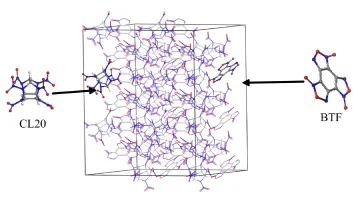
FIG.1 Structures of CL20/BTF supercell(3×2×1)and single molecule.

TABLE II The lattice parameters of CL20/BTF co-crystal.
Here rijis the distance between atom i and atom j,Reijis the equilibrium vdW distance between atoms i and j, and clg,ijis the dispersion energy correction parameter.
B.Simulation of models and details
We studied CL20/BTF co-crystal with parameters from experiments on 1:1 molar ratio CL20/BTF cocrystal cell[10]. Figure 1 shows the structure of CL20/BTF co-crystal supercell in periodic boundary conditions.With the uniform velocity distribution,we obtain the initial speed of all the atoms generated at the temperature of 300 K and minimum energy structure system after optimizing the location of atoms.We then relaxed the system for 1 ps using isothermal-isobaric system(NPT.In NPT,thermostat is Nose-Hoover thermostat is Nose-Hoover thermostat barostat is Nose-Hoover barostat)to set the pressure and temperature at 0 Pa and 300 K respectively,obtaining the contrast result between parameters of the co-crystal cell and experimented results,as shown in Table II.After relaxation,With canonical(NVT.In NVT,thermostat, Nose-Hoover thermostat),through berenden thermostat rapid temperature heating systems,we then performed 60 ps simulation with the temperature set respectively at 2000,2250,2500,2750,and 3000 K.Time step is 0.1 fs.In NPT,Tdampand Pdampare 1 and 1000, respectively;in NVT,Tdampis 10.Time step is 0.1 fs. Bond cutoff is 0.3.The bond value determines whether new bond forms between atoms.Any fragments that are connected by a bond order larger than 0.3 are taken as new molecules.
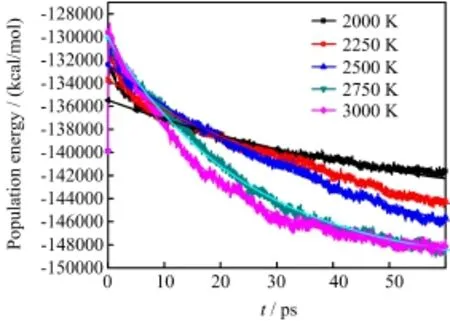
FIG.2 Potential energy for CL20/BTF system.
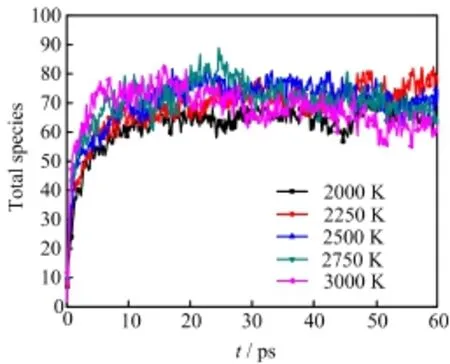
FIG.3 Time evolution of total species for the system.
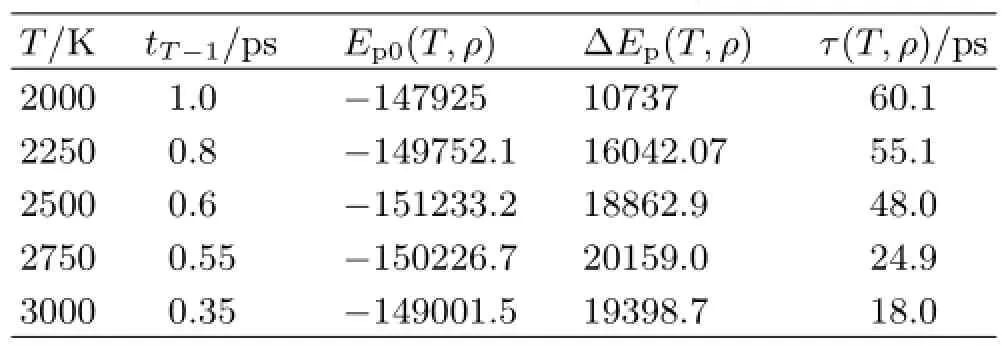
TABLE III Parameters obtained from fitting potential energy of sample.Ep0and ΔEpare in kcal/mol.
III.RESULTS AND DISCUSSION
A.Potential energy and total species
Figure 2 shows the time evolution curve of CL20/BTF co-crystal supercell system at different temperatures.We find at different temperatures,the evolution trend of the potential energy is similar. Because endothermic reaction occurs in an extremely short time in the system,potential energy rapidly increases to the maximum,which is the induction period(induction time tT?1,see Table III).The higher the temperature is,the smaller the tT?1will be,and then the system potential energy decays quickly.The higher the temperature is,the faster the potential energy decays.
Figure 3 shows the evolution curve of the total species over time in the supercell system at different temperatures.At the initial moment,only CL20 and BTF are in the system,and with the continuous decomposition of CL20 and BTF,species gradually increase.During 0?10 ps,species increases rapidly,and chemical reactions reach dynamic equilibrium,so does the species (about 70).As can be seen from the Fig.3,the higher the temperature is,the faster the reaction is,and the more species will be,at the initial stage of thermal decomposition.
B.Total reaction analysis of the Arrhenius law
The system potential energy begins to decay after induction period,and temperature conditions have significant influence on the system's potential energy attenuation.This process can be fitted with the simple exponential function[15].

where Ep0is the asymptotic energy of the products, ΔEpis the exothermicity of the reaction,and τ is overall characteristic time of reaction.Table III shows the parameters obtained under different temperature conditions.Classic Arrhenius law reveals the relationship between the reaction rate and temperature.The logarithmic relation is:

where k is rate constant,A is exponential prefactor,R is general gas constant,Eais activation energy.According to k=1/τ,we obtain the following equation:

where lnτ is proportional to the 1/T.The slope obtained by fitting is shown in Fig.4.Figure 4 is relationship between lnτ and 1/T,τ is the average of 4 samples, seen in Table IV,lnτ and 1/T present linear relationship.Through calculation,we get Ea=65.68 kcal/mol, close to 62.18 kcal/mol presented in Ref.[23].
C.CL20/BTF co-crystal pyrolysis trigger reaction path
First of all,we analyzed CL20 and BTF decomposition on the whole. Figure 5 shows the evolution curve of CL20/BTF co-crystal molecule thermal decomposition.At different temperatures,CL20 decomposes faster than BTF.As the temperature rises,decomposition velocity of CL20 and BTF increases sig-nificantly.At five kinds of temperatures,the CL20 decomposes completely within 2 ps,and BTF decomposes fast within 5 ps with 1?2 molecules left.
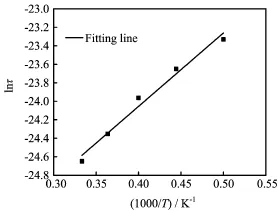
FIG.4 Relationship of lnτ and 1/T.The fitting line is y=-27.2+7.9x.

TABLE IV τ obtained from fitting potential energy of samples.
Through the analysis of the products,we can get CL20/BTF co-crystal initial reaction path.
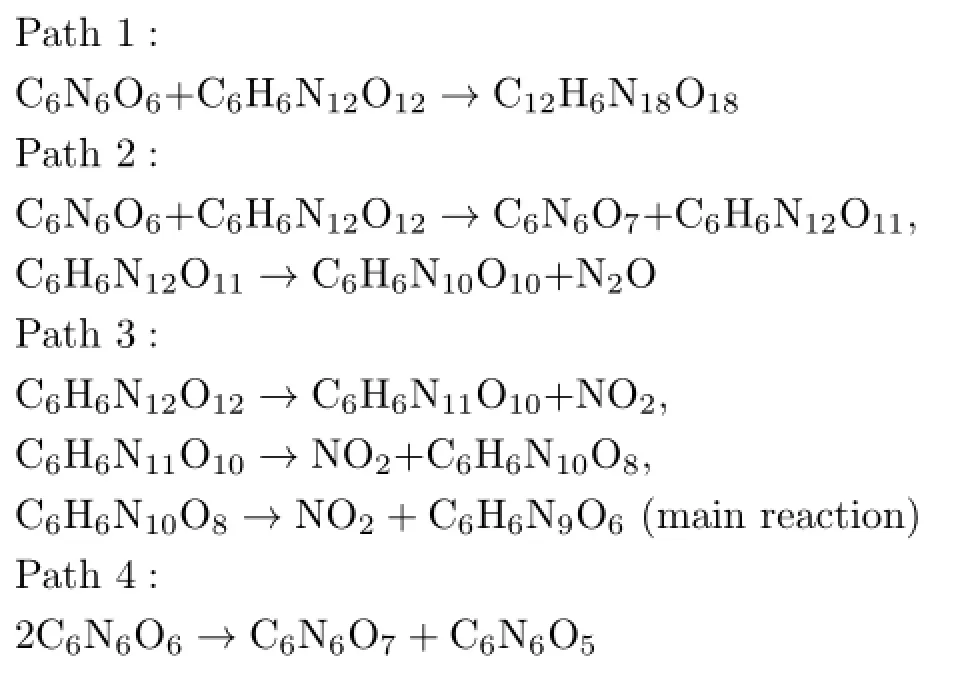
During the initial reaction of CL20/BTF co-crystal, reaction path 3 is the main one.NO2free radical isolates from CL20 first,and then the cage structure damage occurs,which is consistent with the result got from the theories and experiments[24-26]:CL20 decomposition plays a dominant role in the early stage.BTF is also involved in the reaction by forming C12H6N18O18combined with CL20 and forming more stable products such as C6N6O7and C6N6O5with O atoms from CL20 or BTF molecules,and BTF molecular N?O is the easiest to break,which conforms to the results resulted from theory[27]that N?O in BTF molecules is the longest bond length.Then,N2O2occurs,hexahydric carbon ring molecule is relatively stable.
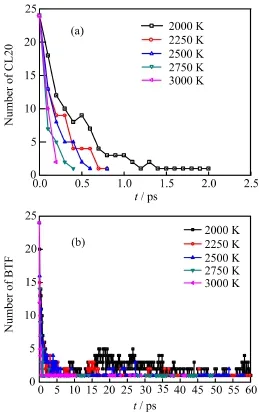
FIG.5 Evolution of(a)CL20 and(b)BTF at various temperature.
D.Main products distribution of CL20/BTF co-crystal thermal decomposition
The evolution curve of main products of CL20/BTF co-crystal thermal decomposition over time at different temperatures is presented in Fig.6.In the process of simulation,the main products are NO2,NO,HNO,N2, O2,N2,H2O,CO2,N2O,and HONO,etc.NO2is a small molecule that appears first,being the main product during the initial stage(0?5 ps).After a sharp increase in the number of NO2in the beginning,the number gradually declines.NO2participates in secondary reaction,producing NO3,NO,N2;moreover,NO2react with C cluster,producing hydroxide radical.Compared with Fig.5,NO2molecular number always peaks(about 60)after CL20 decomposes completely,because NO2mainly comes from the N?NO2bond rupture of CL20, and a CL20 molecular can separate multiple NO2.
As can be seen from the Fig.6,CO2and N2accumulate gradually in limited simulation time and have similar distribution:the higher the temperature is,the sooner they appear,and the larger the producing rateis.At the same temperature,production time of CO2obviously lags behind that of N2.For example,at temperature 2000 K,N2has been produced at the initial stage,but CO2appears only from 20 ps and producing the rate of CO2is smaller than that of N2.At different temperatures,the distributions of CO2are similar,but the temperature has an obvious influence on the output of CO2.H2O is another product of high yield.H2O gradually increases at first,and then falls into balance; the higher the temperature is,the shorter time it takes to reach the balance.This may be caused by the oxygen imbalance of CL20 and BTF,and when CO occurs, the number of H2O becomes stable,suggesting possible existence of CO+H2O→CO2+H2dynamic balance.

FIG.6 Evolution of products at various temperatures.
E.Influence of temperature on the main intermediate products
Figure 7 shows the evolution curve of main intermediate products of CL20/BTF co-crystal thermal decomposition process at different temperatures.It shows the evolution and distribution of NO2:the higher the temperature is,the shorter time it takes to reach the peak value and the sooner it begins to decay,mainly because the NO2in the reaction generates NO3,NO,N2,and NO3.NO and N2O are important intermediate products,and these products have similar evolution trend to that of NO2,which rapidly increases to the maximum and then begins to decay.
NO3occurs later than NO2,and the production rate of NO3is smaller than that of NO2. NO3mainly comes from the combination of NO2and O,the break of N?NO3which is produced by the combination N?NO2and O.The NO3molecule maximum and the time NO3takes to reach maximum decrease as the temperature increases.The production of NO and N2O is significantly lower than the production of NO2.The N2O mainly comes from the CL20 cage structure damage. Because the N2O has strong oxidation,the consumption of N2O is very fast,and the higher the temperature is, the faster the consumption is.On the whole,products such as N2O2,HNO,and HONO during thermal decomposition first increase and then decrease;because of instability of these products,their numbers have great volatility in the process of thermal decomposition.
IV.CONCLUSION
Through studies on the thermal decomposition of CL20/BTF co-crystal using ReaxFF/lg reaction force field simulation at temperature as high as 2000 K to 3000 K,we obtain valuable details such as potential energy,evolution curves of products,initial reaction path and decomposition products.With the analysis of evolution curves of potential energy based on exponential function,we obtain the overall characteristic time;then we get the activation energy Ea=60.8 kcal/mol of CL20/BTF co-crystal:via a description of the total package reaction with classical Arrhenius law.Based on the initial path of CL20/BTF co-crystalthermal decomposition we studied,we conclude that N?NO2of CL20 molecules breaks first,working as a dominant role in the starting stage of thermal decomposition under the condition of different temperatures,and that CL20 molecules all completely decompose before BTF molecular do regardless of different temperature.We also find that the main products of CL20/BTF co-crystal are NO2,NO,NO3,HNO,O2, N2,H2O,CO2,N2O,and HONO,etc.,among which N2,H2O and CO2are the main terminal products;N2and CO2accumulate gradually during the simulation process;CO2forms later than N2and more susceptible to temperature.NO2,NO,NO3and N2O are important intermediate products,and they present similar evolution curve at different temperatures,with NO2outnumbering the other three.The temperature has certain influence on the products.This work provides atomic level detailed information on thermal decomposition processes of CL20/BTF co-crystal such as reaction path,contributing to a better understanding of detonation process and its reaction process,also providing part of the characteristic parameters for further establishment of chemical reaction kinetics model.

FIG.7 Evolution of main intermediate products at various temperature.
[1]A.T.Nielsen,A.P.Chafin,S.L.Christian,D.W. Moore,M.P.Nadler,R.A.Nissan,and D.Vanderah, J.Tetrahedron.54,11793(1998).
[2]R.L.Simpson,P.A.Urtiew,D.L.Ornellas,G.L. Moody,K.J.Scribner,and D.M.Hoffman,Propell. Explos.Pyrot.22,249(1997).
[3]O.Ordzhonikidze,A.Pivkina,Y.Frolov,N.Muravyev, and K.Monogarob,J.Therm.Anal.Calorim.105,529(2011).
[4]C.Y.Guo,H.B.Zhang,X.C.Wang,and J.Sun, Mater.Rev.26,49(2012).
[5]C.Y.Zhang,Y.F.Cao,H.Z.Li,Y.Zhou,J.H.Zhou, Tao Gao,H.W.Zhang,Z.W.Yang,and G.Jiang, CrystEngComm.15,4003(2013).
[6]O.Bolton and A.J.Matzger,Angew.Chem.Int.Ed. 50,8960(2011).
[7]Z.W.Yang,Y.L.Zhang,H.Z.Li,X.Q.Zhou,F.D. Nie,J.S.Li,and H.Huang,Chin.J.Energ.Mater.20, 674(2012).
[8]O.Bolton,L.R.Simke,P.E.Pagoria,and A.J. Matzger,Cryst.Growth Des.12,4311(2012).
[9]Y.P.Wang,Z.W.Yang,H.Z.Li,Q.Zhang,J.H. Wang,and Y.C.Liu,Propell.Explos.Pyrot.39,590 (2014).
[10]Z.W.Yang,H.Z.Li,X.Q.Zhou,C.Y.Zhang,H. Huang,J.S.Li,and F.D.Nie,Cryst.Growth Des.12, 5155(2012).
[11]K.Chenoweth,S.Cheung,A.C.T.van Duin,W.A. Goddard,and E.M.Kober,J.Am.Chem.Soc.127, 7192(2005).
[12]A.C.T.van Duin,Y.Zeiri,F.Dubnikova,R.Kosloff, and W.A.Goddard,J.Am.Chem.Soc.127,11053 (2005).
[13]T.Cheng,A.Jaramillo-Botero,W.A.Goddard,and H.Sun,J.Am.Chem.Soc.136,9434(2014).
[14]D.Furman,R.Kosloff,F.Dubnikova,S.V.Zybin,W. A.Goddard,N.Rom,B.Hirshberg,and Y.Zeiri,J. Am.Chem.Soc.136,4192(2014).
[15]A.Strachan,E.M.Kober,A.C.T.van Duin,J.Oxgaard,and W.A.Goddard,J.Chem.Phys.122,054502 (2005).
[16]D.Z.Guo,Q.An,S.V.Zybin,W.A.Goddard,F.L Huang,and B.Tang,J.Mater.Chem.A 3,5409(2015).
[17]Z.Yang and Y.H.He,Acta Phys.-Chim.Sin.in press, doi:10.3866/PKU.WHXB201604293
[18]Z.Yang and Y.H.He,Acta Phys.-Chim.Sin.32,921 (2016).
[19]http://lammps.sandia.gov/(accessed Mar.20,2016).
[20]A.C.T.van Duin,S.Dasgupta,F.Lorant,W.A.Goddard,J.Phys.Chem.A 105,9396(2001).
[21]A.C.T.van Duin,A.Strachan,S.Stewman,Q.S. Zhang,and W.A.Goddard,J.Phys.Chem.A 107, 3803(2003).
[22]L.C.Liu,Y.Lin,S.V.Zybin,H.Sun,and W.A. Goddard,J.Phys.Chem.A 115,11016(2011).
[23]C.Y.Zhang,Y.F.Cao,H.Z.Li,Y.Zhou,J.H.Zhou, T.Gao,H.B.Zhang,Z.W.Yang,and G.Jiang,CrystengComm.15,4003(2012).
[24]E.F.C.Byrd and B.M.Rice,J.Phys.Chem.111, 2787(2007).
[25]U.R.Nair,R.Sivabalan,G.M.Gore,M.Geetha,S. N.Asthana,and H.Singh,Combust.Explo.Shock.41, 121(2005).
[26]R.Turcotte,M.Vachon,Q.S.M.Kwok,Wang,and D. E.G.Jone,Thermochim.Acta.433,105(2005).
[27]D.Xiang,Q.Wu,Z.C.Liu,W.H.Zhu,and H.M. Xiao,Can.J.Chem.92,1131(2014).
(Dated:Received on March 22,2016;Accepted on July 4,2016)
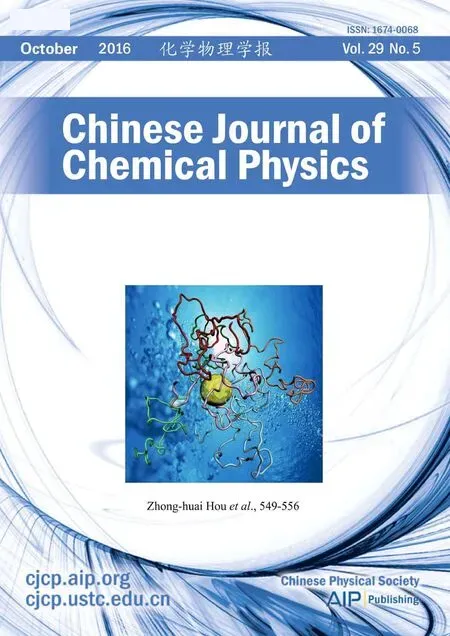 CHINESE JOURNAL OF CHEMICAL PHYSICS2016年5期
CHINESE JOURNAL OF CHEMICAL PHYSICS2016年5期
- CHINESE JOURNAL OF CHEMICAL PHYSICS的其它文章
- Preparation of Bio-hydrogen and Bio-fuels from Lignocellulosic Biomass Pyrolysis-Oil
- Combination Computing of Support Vector Machine,Support Vector Regression and Molecular Docking for Potential Cytochrome P450 1A2 Inhibitors
- Working Condition Real-Time Monitoring Model of Lithium Ion Batteries Based on Distributed Parameter System and Single Particle Model
- Hydrodeoxygenation of Anisole over Ni/α-Al2O3Catalyst
- Highly Efficient and Selective Removal of Pb(II)ions by Sulfur-Containing Calcium Phosphate Nanoparticles
- Efficient Removal Phenol Red over Ternary Heterostructured Ag-Bi2MoO6/BiPO4Composite Photocatalyst
